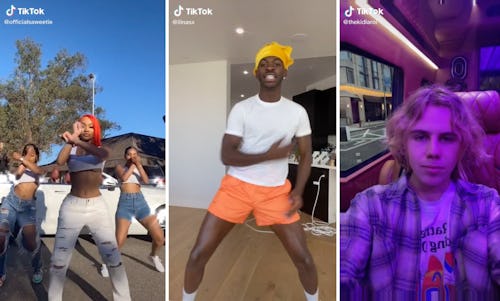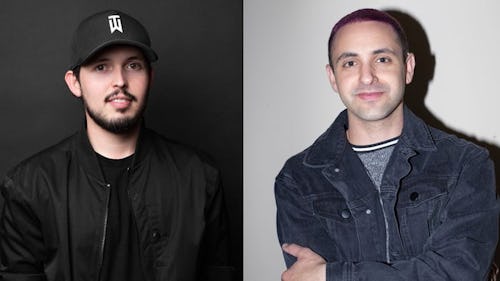
People go viral on TikTok every day, but few understand why some videos catch fire and others flop. How did the fusion of Paul Anka’s 1959 song about delicate gestures of love (“Put Your Head On My Shoulder”) and Doja Cat’s sultry 2019 instrumental (“Streets”) inspire endless video streams of people undressing behind a red silhouette filter, catapulting both songs to viral supremacy? Why does a TikTok account for Daisy, a Golden Retriever, have 1.4 million likes? Was it the timing of the #silhouettechallenge posts? Is it America’s meme-driven obsession with man’s best friend?
One of the people who know the answers to these questions is Griffin Haddrill, the 24-year-old co-founder and CEO of VRTCL. The company considers itself a “TikTok-first agency,” although not officially affiliated with TikTok. He’s boosted songs from the likes of Saweetie, Lil Nas X and The Kid Laroi, helping them become the platform’s hottest sounds. The dance challenge that sent Saweetie’s “Tap In” to the top of TikTok’s Top Trending charts was a result of VRTCL’s social media ingenuity and connections. Haddrill began to understand what made TikTok, well, tick, in 2019 (at the time, the app was called Musical.ly), through an unreleased song called “Trippin’ Toddlers” about an adult jokingly picking on kids. The song, created by unsigned artist REI AMI, would have likely never played on the radio. But here, that didn’t matter.
“We put the song on Musical.ly with a couple of videos. Within two weeks we had 300,000 videos made and we were like, ‘Holy shit, this is real.’ Billie Eilish ended up following her, she signed to Billie Eilish’s agent, and they got a record deal — all catapulted from that moment we created,” Haddrill tells Mic. “That’s when I took a step back and was like, ‘Alright, I need to take this seriously and put more attention on it.’”

Shortly after, he co-founded the boutique marketing agency VRTCL. They developed a software program that automatically reports TikTok data, providing metrics on everything from total views and followers to comments, shares, and likes. This depth of data lets Haddrill and Young tap into why people do what they do on TikTok, and why songs are the way they are in today’s music industry, on a level many can’t access.
Speaking with Mic, one of Gen Z’s first TikTok moguls breaks down the human habits he taps into to make songs go viral, why average people see massive success on TikTok, and what the hell a TikTok-first agency actually is.
Mic: Your press release names VRTCL as “a TikTok-first agency.” What does that mean?
Griffin Haddrill: We’re trend architects. We know how to make viral content. We know how to adapt to an artist’s voice and audience while simultaneously understanding the consumerism that lives on TikTok. So, instead of us playing craps, we’re playing Blackjack. Our odds are a little better because we were born in this world. We were born from Musical.ly into TikTok, and we got to see the evolution consistently happen throughout.
How does the average person contribute to a song’s success on TikTok?
The coolest thing about TikTok is that anyone can go viral. That’s the beauty of it. On Instagram, Facebook, and YouTube, you’re restricted by your follower count. You can only reach as many people as follow you. But, with TikTok, anyone can go viral because of the discoverability of the ‘For You’ page. If you make a good video, you have the opportunity to go viral and could be the next Addison Rae or Charli D’amelio. Eighty-three percent of people who started TikTok have made a video, which means people actually want to be on the platform, engage with an audience and have the potential of going viral. If we’re pushing a song, brand, or campaign, there are all of these people willing to make a video to those things and are excited because they have that opportunity at virality.
What are the human habits you leverage to make a song go viral on TikTok?
For us, it’s about understanding what’s happening in this time — from a cultural standpoint, to a seasonal standpoint, to if mercury is in retrograde, to if there’s a big push in certain communities. We think about ‘Who’s our demographic here? How does our demographic want to engage with this content?’ If it feels forced and you’re just seeing another white kid with a beanie and dangling earrings, does that make you want to replicate the video? Most likely not. But, if you’re seeing somebody who’s really about the culture, funny, or who really feels connected with their audience, it feels authentic. If we get a draft in from an influencer and something feels forced and looks forced, it likely is, and is a waste of money. But, if it feels authentic to them, they’re owning it and it’s an extension of their body, those little moments are what we live for.
Your agency is responsible for five songs reaching #1 on TikTok Top Trending charts, one of the earliest being Saweetie’s “Tap In” from summer 2020. What did your agency do to make that go viral?
At that time, we weren’t in Saweetie’s full team yet. I called Lou, her manager, and said, “This is a smash. This is going to be huge. This is what the world needs and wants right now.” So, we developed a plan where we went to every dance creator we knew. I had no budget at the time. I needed to prove to myself I wanted to be here and earn my spot. I went to all those dance creators like, “Can you do us a favor? Help us think of a dance.” So, we came up with a bunch of different dances. We sent it to Saweetie’s management like, “Look, this could be a moment.” At the time, ‘Tap In” was popping everywhere else, while on TikTok it was moving but it wasn’t on that J-curve, so to speak. We ended up getting all of those influencers to start posting their dances and eventually one of those dances caught on. After that, it was guns blazing. Then the song started getting 30, 40, 50, 100,000 video creations a day and we were like, “Holy shit.” The manager called me and opened his arms for us to join the team, which is cool.
What are some interesting tidbits about TikTok you’ve gleaned from your internal data?
With Instagram, everyone is looking for their best time to post. Think about it, the reason why that’s their best time on Instagram is because there are tens of millions of people on that app at that time, but they’re all thinking the same thing. They’re all posting at the same time. So, that might be your best time for engagement, but it’s the same for everyone. You’re not special. The cool thing about TikTok is your content has a better chance of going viral or being successful at the times of the least audience time and when the least content is being uploaded. We’ve done this so many times, even with Saweetie. We will post something at midnight or 11 pm, or six in the morning. It’ll go viral because the content output during that window is so low. The way the TikTok algorithm works is the For You page has to aggregate content at all times. If 100 million videos are uploaded at 2 pm but only 10 million are uploaded at 4 am, then our chances of going viral have increased 10 fold.
The other thing a lot of people don’t know, which we only know from personal experience, if you create an account and post content within a 14 to 30 day period, your likelihood of having a viral video is much higher because TikTok is rewarding you for being on the platform and wants to encourage your user behavior to continue to post videos. I always tell artists and influencers this: if you created a TikTok, be ready to create content immediately, because the first 30-day period will likely show you some success on the platform, which you can hopefully continue to repeat through your TikTok career.
You’ve helped market songs like The Kid Laroi’s “Stay” that have topped the Billboard Hot 100. Billboard doesn’t count TikTok streams, so what’s the correlation between TikTok success and Billboard success?
Here’s a great example: “Heatwave” by Glass Animals was a song I’ve been working on since 2020. I’ve done eight campaigns on that. All of a sudden, it’s on the Global Billboard charts at No. 8. That was a song that came out a year and change ago. It’s now on the Billboard chart so far down the road because it’s now close to 1.5 million video creations [on TikTok]. That shows there’s a direct connection between TikTok and the Billboard charts. With “Stay” and “Montero,” both of those songs were massively viral on TikTok. If you look at any of the songs on the Billboard Top 10 [as of October 14] — Ed Sheeran, Ariana Grande, Drake, Lil Nas X — and look at what the song’s doing on TikTok you’ll see a direct correlation. But, I still believe a good song is a good song, and TikTok is a way to amplify a good song. No one platform should take credit for one song’s success.
With TikTok’s massive influence, there are now ‘TikTok songs,’ made specifically to do well on TikTok. What do those sound like?
I listen for the beat. I also listen for the instrumental, tempo, and lyrics. It has good snappy lyrics that are clear with a good beat and has a tempo that can reach an audience. If it’s a faster tempo, it’s going to be more leaning towards a dance, glow-up, or transition video. If it’s a little slower, we might be pulling back and thinking of relationship-type videos and trends that surround slower audio. Polo G’s “Rap Star” is a great example of that.
Can an artist survive on just TikTok?
An artist can absolutely survive on just TikTok. What’s great about the evolution of the music industry is it’s become more decentralized over time. Twenty years ago, you weren’t a successful artist unless you had a record label. Now, you can be a successful artist without a record label, manager, or agent. You just need to be authentic and create good music and content. I think that’s what TikTok allows artists to do. You can cultivate followership and be able to have a really sustainable career. TikTok is an added layer of the decentralization of the music industry which supports the independent artist.
What’s the future of TikTok’s influence on the music industry?
There will continue to be the rise of the independent artists in the music industry through TikTok. Along with that, TikTok will continue to be a platform for people to have discoverability, which no social platform has done well. YouTube came out with Shorts, Instagram came out with Reels, and everyone is coming out with a discoverable feature but they didn’t start there. TikTok started with discovery and music first, and because of that, it’ll continue to remain a platform where people can be discovered and can be music-first driven.







